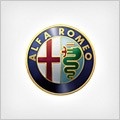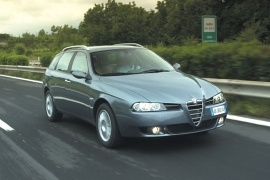
ALFA ROMEO 156 Sportwagon
Generations Timeline, Specs and Pictures

When Alfa Romeo made the station wagon for the model 156, it didn’t want to make a roomier vehicle; it aimed at those who needed a longer loading area for skis and snowboards.
Introduced in 1997, the Alfa Romeo 156 was already six years old when the carmaker finally decided to give the car a mid-life cycle impulse. The station wagon was only three years old since Alfa Romeo introduced it in 2000. It was a difficult task since the car still looked fresh. But the Italian brand refreshed both versions of the 156; the sedan and the station wagon, which was named Sportwagon.
At the front, there was a new front fascia that sported wider, clear-lens headlights and an enlarged Alfa shield in the middle. The bumper sported a center grille in the middle and two side-scoops for the round fog lights. Despite all the critics that blamed the elliptic door-mirrors, Alfa Romeo kept them because they looked better. At the back, the Sportwagon featured the rear-doors handles masked into the C-pillars. Behind them, a third, sloped-down window created the image of a shooting brake. At the back, the carmaker introduced new taillights.
Inside, there were minimal changes on the dashboard, with black dials instead of white as for the 2000 model year. The carmaker already improved the cabin in 2002, so in 2003 only made slight touches for specific versions.
Under the hood, Alfa Romeo brought a range of four gasoline and three turbo-diesel engines paired as standard to five or six-speed manual transmission, depending on the version. An automated (named Selespeed) gearbox was on the options list. Alfa Romeo kept the same double-wishbone system at the front for the suspension, with McPherson struts in the rear.

Alfa Romeo refreshed the 156 range in September 2001 and gave people one more reason to buy it in the station wagon shape named Sportwagon: the GTA.
The Italian carmaker took the name from the former sporty 1965 GTA (Grand Turismo Aleggerita) and improved the Sportwagon in every way it could. Thanks to its enhanced design, stunning interior, and more punchy powertrain, it should make it to the top of the automotive news. Unfortunately, it was shown on 9/11 2001, at Frankfurt Motor Show.
The designers replaced all the bumpers and rocker panels from the standard Alfa Romeo 159 package. They replaced it with an air-splitter at the front, inspired by a Formula 1 car’s nose-wing. On the sides, the rocker panels took their aerodynamic role seriously and streamlined the air along with the bodywork and over the rear fenders. At the back, the hatchback-style greenhouse sported a roof spoiler at the top of the tailgate, while the rear wrapped around bumper was extended on the lower side and featured a twin exhaust on the car’s left side.
With its leather-clad interior, sports-bucket seats with integrated headrests, and aluminum trims and pedals, the Alfa Romeo 156 GTA stood apart from the rest of its siblings. The whole atmosphere was sporty, and the high-bolstered seats promised good side support during hard cornering. With more headroom than its sedan sibling, the Sportwagon version was more comfortable for the rear seat passengers.
But the real change was under the hood, where Alfa Romeo installed a 3.2-liter V-6 engine. It was tuned to provide 250 hp and mated to a standard six-speed manual gearbox. As an option, the Italian brand offered an option for its Selespeed (automated) gearbox with paddle-shifters.

Alfa Romeo didn’t want to use the station-wagon name for its cars, which were considered too sporty to bear a sort of utility-vehicle name.
So, the Sportwagon name was selected.
The Alfa Romeo 156 was a major breakthrough for the Italian car-maker. It featured a new design language than its predecessor in 1997 when it was introduced to the public. It even won the 1998 “European Car of the Year” award. It was a sport-sedan with true Alfa Romeo DNA in it.
From the front to the B-pillar, the Alfa 156 Sportwagon looked similar to the sedan version. After the B-pillar, the extended roof changed the shape of the car. Since the company didn’t want to be judged like a regular family estate, the sloped and short side made the car look closer to an extended hatchback rather than a station-wagon.
Inside, there was more headroom for the rear passengers, but strangely, less luggage room. Since the rear overhang was not bigger, and the rear retractable shelf was placed lower, the standard trunk space was smaller with the rear seats up.
For the drivetrain, the Alfa Romeo 156 featured the same four gasoline units and two diesel units, offered in various power outputs. It was offered with a manual or robotized transmission (Selespeed). A special version, named GTA, was launched in 2001 and it was powered by a 3.2-liter V6 engine, which offered 250 hp.























































